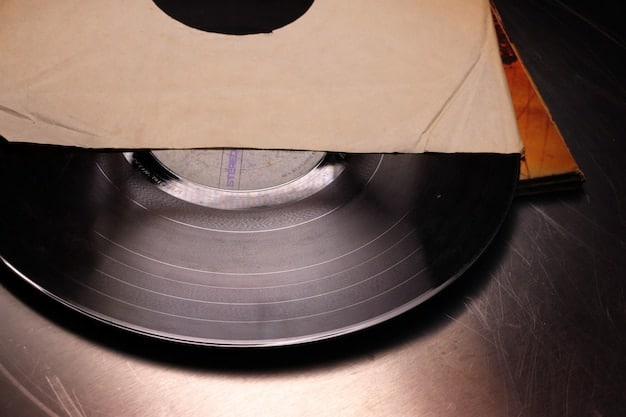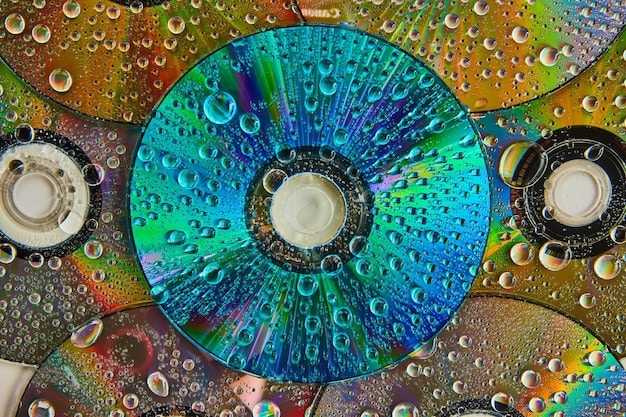Vinyl Records Resurgence: Why Physical Albums Are Back in the US

The resurgence of vinyl records in the US is driven by a desire for tangible music experiences, superior sound quality, and the cultural cachet associated with collecting physical albums, appealing to both audiophiles and younger generations seeking a nostalgic connection to music.
The unmistakable crackle of a needle dropping onto vinyl has become increasingly familiar as of late. But what’s behind the resurgence of vinyl records: why are physical albums making a comeback in the US? It’s a question that resonates with music lovers across generations.
The Allure of Analog: Why Vinyl Resonates Today
The digital age has undoubtedly transformed how we consume music, yet the tangible charm of vinyl records persists. This isn’t merely a fad; it’s a multifaceted phenomenon rooted in sound quality, sensory experience, and a yearning for authenticity in an increasingly digital world.
Superior Sound Quality: The Warmth of Vinyl
One of the primary reasons for vinyl’s enduring appeal is its unique sound. Digital music is often compressed, sacrificing detail and warmth for convenience. Vinyl, on the other hand, offers a richer, more dynamic soundstage.
The Tactile Experience: More Than Just Music
Holding a vinyl record, examining the artwork, and carefully placing the needle onto the groove engage multiple senses. This tactile experience transforms listening to music into a ritual, fostering a deeper connection with the music and the artist.
- Audiophile Appeal: Vinyl enthusiasts often cite the uncompressed sound as a key factor in their preference.
- Sensory Engagement: The act of handling a record enhances the listening experience.
- Nostalgia Factor: Many listeners associate vinyl with cherished memories and a simpler time.
In conclusion, the allure of analog extends beyond sound. It’s about the complete sensory experience and a rejection of the often sterile and fleeting nature of digital consumption.
A Generational Shift: Vinyl’s Appeal to Younger Audiences
While nostalgia undoubtedly plays a role in vinyl’s resurgence, its appeal isn’t limited to older generations. Younger listeners are increasingly drawn to the format, often discovering the joy of physical music through vinyl.
Discovering Something Tangible in a Digital World
For many young people, vinyl represents a departure from the ephemeral nature of streaming. Owning a physical album provides a sense of ownership and investment in the music they love.
Vinyl as a Statement: Culture and Collectibility
Vinyl collecting has become a subculture in itself, with enthusiasts trading records, attending record fairs, and sharing their passion with others. Owning certain albums can be a statement of musical taste and cultural awareness.

- Counter-Culture Trend: Vinyl offers a tangible alternative to digital music.
- Community Building: Record collecting fosters social connections and shared experiences.
- Status Symbol: Owning rare or sought-after vinyl albums can be a source of pride.
In conclusion, young audiences are driving a significant portion of vinyl’s resurgence, attracted by its tangible nature, cultural cachet, and the sense of community it fosters.
The Economic Impact: Vinyl Sales and the Music Industry
The resurgence of vinyl records has had a significant economic impact on the music industry, providing a much-needed boost in revenue for record labels, artists, and independent record stores.
Vinyl Sales Surge: A Revenue Stream for Artists
Vinyl sales have been steadily increasing for over a decade, reaching record levels in recent years. This provides artists with a direct revenue stream, supplementing income from streaming services.
Supporting Independent Record Stores: A Boost for Local Economies
The vinyl revival has also fueled the growth of independent record stores, which serve as hubs for music lovers and cultural enthusiasts.
- Revenue Diversification: Vinyl sales offer a concrete revenue source for independent artists.
- Local Business Growth: The demand for vinyl supports independent record stores.
- Cultural Preservation: Record stores play a crucial role in preserving music history and culture.
In summary, the economic impact of vinyl’s resurgence is undeniable, benefiting artists, record stores, and the music industry as a whole.
The Art of Album Art: Visual Appeal and Storytelling
Beyond the sound, vinyl offers a visual experience that digital music simply can’t replicate. Album art becomes a canvas for artists, enhancing the storytelling and emotional impact of the music.
Large-Format Artwork: An Immersive Experience
The 12×12 inch format of vinyl album art allows for more detailed and impactful visuals. This provides artists with a unique opportunity to express their vision and create a complete sensory experience for the listener.
Collectible Editions: Limited Releases and Special Packaging
Many artists release limited edition vinyl albums with unique artwork, colored vinyl, and special packaging. These collectible editions add to the appeal of vinyl for collectors and fans.

- Visual Storytelling: Album art complements and enhances the music’s narrative.
- Artistic Expression: Vinyl provides a large canvas for artists to showcase their creativity.
- Collectible Value: Limited editions and unique packaging add to the appeal of vinyl.
In conclusion, the art of album art is an integral part of the vinyl experience, offering a visual feast that enhances the music and appeals to collectors and fans alike.
The Longevity of Vinyl: A Timeless Format in the Digital Era
Despite the dominance of digital music, vinyl has proven to be remarkably resilient, maintaining its appeal and even experiencing a resurgence in recent years.
Physical Media: Owning a Piece of Music History
In a world of ephemeral digital files, owning a physical vinyl record provides a sense of permanence and connection to music history. Vinyl albums can be passed down through generations, becoming treasured artifacts.
Analog vs. Digital: A Matter of Preference and Taste
While digital music offers convenience and accessibility, vinyl provides a unique sonic and sensory experience that appeals to many listeners. The choice between analog and digital is ultimately a matter of personal preference.
- Cultural Significance: Vinyl represents a connection to past musical eras.
- Tangible Ownership: Owning a physical record provides a sense of investment.
- Personal Preference: Vinyl offers a unique listening experience.
In summary, the longevity of vinyl is a testament to its enduring appeal, offering a tangible and timeless alternative to digital music.
Challenges and Future of the Vinyl Resurgence
While the vinyl resurgence is undoubtedly a positive trend for the music industry, it also faces challenges, including production capacity, environmental concerns, and competition from other formats.
Production Capacity: Meeting the Growing Demand
The demand for vinyl records has strained the production capacity of pressing plants, leading to longer lead times and higher costs. This presents a challenge for record labels and artists.
Environmental Impact: Sustainable Vinyl Production
The production of vinyl records can have a significant environmental impact. Efforts are underway to develop more sustainable production methods and materials.
- Infrastructure Needs: Expanding pressing plant capacity is crucial.
- Sustainable Practices: Eco-friendly vinyl production must be prioritized.
- Format Competition: Balancing vinyl with digital music is essential.
In conclusion, while challenges exist, the future of the vinyl resurgence looks bright, driven by passionate fans, innovative artists, and a commitment to sustainability.
| Key Aspect | Brief Description |
|---|---|
| 🎧 Sound Quality | Vinyl is praised for its warm, uncompressed sound. |
| 🖼️ Album Art | Large format art enhances the music experience. |
| 🕰️ Nostalgia | Vinyl connects people to cherished music memories. |
| 🌱 Sustainability | Efforts are in place to produce vinyl more sustainably. |
FAQ
▼
Vinyl records offer a unique and tangible experience that digital music lacks. The warmer sound, the act of handling the record, and the visual appeal of album art all contribute to its resurgence.
▼
Many audiophiles believe that vinyl offers a superior sound quality due to its uncompressed format, capturing more detail and warmth than compressed digital files. However, this is subjective and depends on listening equipment.
▼
While trends come and go, the consistent growth in vinyl sales over the past decade suggests it’s more than just a fleeting fad. It represents a genuine appreciation for physical music formats.
▼
Vinyl records can be purchased at independent record stores, online retailers, and even some big-box stores. Many artists also sell vinyl directly through their websites or at concerts.
▼
It can be, but it doesn’t have to be. New vinyl releases can be pricier, but used records can often be found for reasonable prices at record stores or online marketplaces. The cost depends on how extensive your collection is.
Conclusion
The comeback of vinyl records in the US isn’t just a nostalgic trip, but a testament to the enduring appeal of tangible music and the unique experience it provides. From the warmth of analog sound to the immersive artwork, vinyl offers a sensory-rich alternative to the digital world that continues to captivate music lovers of all ages.





